Carpal hyperextension in dogs occurs when a dog’s carpus (i.e. wrist) becomes unstable, causing it to drop toward the ground. Integrative veterinarian Dr. Julie Buzby explains what causes carpal hyperextension in dogs and discusses the symptoms, diagnosis, treatment, and prognosis.
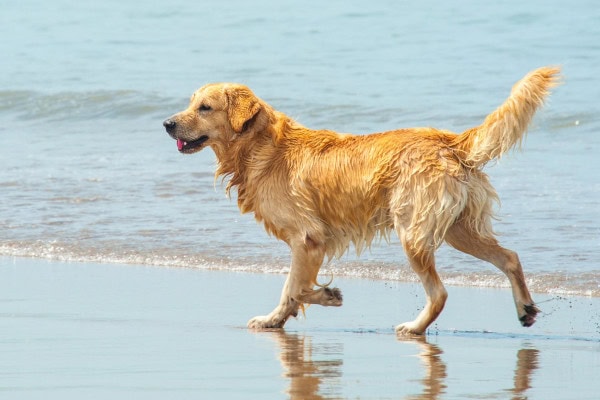
If you have been a dog parent for awhile, chances are good you are somewhat familiar with common orthopedic conditions in dogs such as hip or elbow dysplasia, an ACL tear, and luxating patella. But have you every heard of carpal hyperextension in dogs? If not, now is the perfect time to learn what this condition involves, how to recognize it, and what it might mean for your dear dog.
What is carpal hyperextension in dogs?
Carpal hyperextension in dogs is an orthopedic condition where a dog’s wrist (aka carpal joint) drops closer to the ground (hyperextends). Typically, this occurs when the structures that support the carpal joint become damaged or start to degenerate.
To get a better idea of what happens in canine carpal hyperextension, it helps to understand the anatomy of a dog’s carpus.
Dog carpal anatomy
The carpal joint in dogs is analogous to the wrist joint in people. It is made up of the lower end of the radius and ulna (i.e. forearm bones), two rows of small cuboidal carpal bones, and the upper end of the metacarpals (i.e. long bones between the carpus and toes). Together these structures form four separate joints:
- Antebrachiocarpal joint— between the ends of the radius and ulna and the first row of carpal bones
- Middle carpal joint—between the first and second row of carpal bones
- Carpometacarpal joint—between the second row of carpal bones and the metacarpals
- Intercarpal joints—between the individual carpal bones
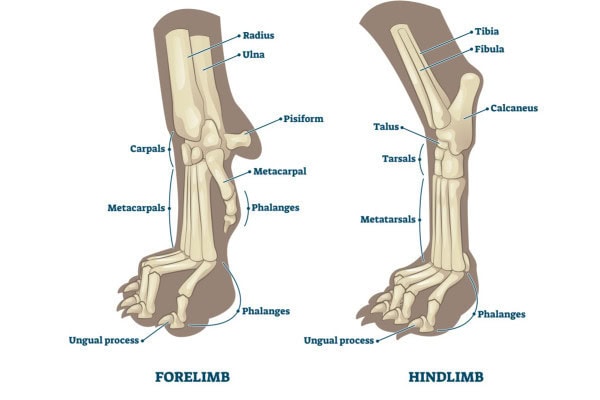
Connective tissue such as ligaments and fibrocartilage runs along the front, back, and sides of the carpus to help stabilize it. These structures are critical for keeping the carpus from hyperextending when in a weight-bearing position.
Due to its anatomy, normally the carpus only extends slightly but has a great deal of flexion. This means that it can flex enough for the bottom of the paw to touch the back of the forelimb. But normally the carpus doesn’t bend much the other way (i.e. extend) when the dog is bearing weight on the leg.
However, if the joints or ligaments holding up the carpal joint are damaged or start to break down, the carpal joint no longer has good support. Without adequate stabilization, the carpal joint will hyperextend when the dog bears weight on the leg. In other words, the back of the carpus (where that cute little “upper paw pad” lives) will get closer to the ground than normal. In some severe cases of canine carpal hyperextension, the back of the carpus will even be touching the ground.
What causes carpal extension in dogs?
In dogs, there are several potential causes of carpal hyperextension: trauma, abnormal development, degeneration of ligaments, inflammatory conditions, and endocrine conditions. Let’s touch on each one.
Trauma
Trauma is the most common cause of carpal hyperextension in dogs. If the dog falls or jumps from a height and lands hard on the front legs, this can fracture the carpal bones or damage the supporting ligaments and fibrocartilage. Additionally, young canine athletes such as racing Greyhounds can suffer trauma to the carpus when running.
Trauma is more likely to cause carpal hyperextension in one leg, but could occur in both legs at the same time.
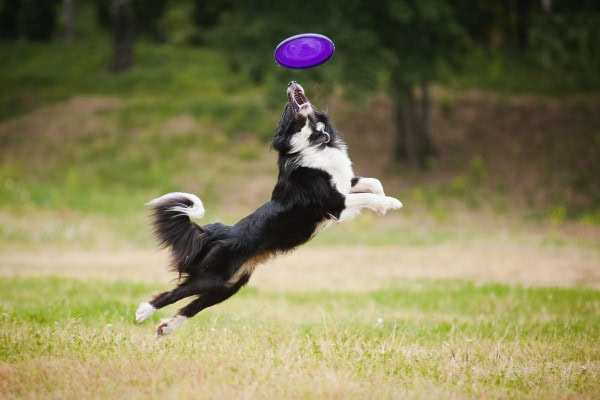
Abnormal development
Sometimes young puppies (under four months old or so) will have carpal hyperextension because the carpal ligaments are weak. This may occur if the puppy was wearing a split, cast, or bandage for awhile. Or poor nutrition plus rapid growth can also cause ligament weakness, especially in large breeds. Usually affected puppies walk with carpal hyperextension in both front legs.
Degeneration of the ligaments
Sometimes as the dog ages, the ligaments and other supporting structures for the carpus get worn out. As the ligaments degenerate, they can no longer do their job of supporting the carpus. Degenerative hyperextension is more commonly seen in large breed older dogs. And Collie breeds seem to be particularly predisposed to degenerative carpal hyperextension.
Inflammatory conditions
If a dog has erosive immune-mediated arthritis or another condition that attacks the joints, he or she might also develop carpal hyperextension. Usually it will affect both carpi and may also impact other joints such as the hock joints (ankles).
Endocrine conditions
While less common than some of the other causes, diabetes in dogs, Cushing’s disease in dogs, or other endocrine conditions may cause the ligaments to be more mobile than normal. This can lead to carpal hyperextension in both front legs and/or tarsal hyperflexion in the hind legs.
What are the symptoms of carpal hyperextension in dogs?
As you can imagine, one of the biggest signs of canine carpal hyperextension is abnormal posture of the front leg(s). More specifically, the back of carpus will be closer to the ground than normal when the dog is standing. Sometimes the change is very obvious, but other times it can be a bit more subtle.
If the dog suffered an acute injury or trauma to the leg, you might notice your dog limping on a front leg, acting painful, or not wanting to bear weight on the leg. Also, the joint may be inflamed and swollen. On the other hand, if the carpal hyperextension has been going on for awhile, the main sign might be a fibrous thickening of the area around the joint and poor range of motion.
Additionally, you may see symptoms related to the condition that caused the carpal hyperextension. For example, a dog with erosive arthritis may have pain and swelling in multiple joints. Or a dog with diabetes might be drinking and urinating more often than normal.
If you see any of these signs, or your dog is limping and you don’t know why, please make an appointment with your vet.
How will the vet diagnose carpal hyperextension?
Carpal hyperextension is typically diagnosed using a combination of findings on the physical exam, imaging, and other diagnostic tests. Your vet will start with a comprehensive clinical examination. He or she may be able to tell that the affected forelimb has an obvious plantigrade stance (meaning the wrist is close to touching the ground). Or the vet might be able to detect more subtle cases of carpal hyperextension by using a goniometer to measure the angle of the carpal joints.
Your vet may also recommend X-rays of the carpus. Since taking X-ray involves manipulating a painful joint, the vet may suggest sedating or anesthetizing your dog for the procedure. This is a good way to keep your dog comfortable and ensure the veterinary team can properly position the leg to get good diagnostic views.
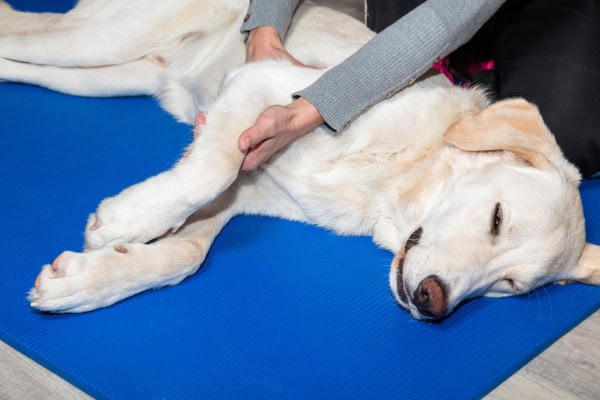
Often the vet will take stressed views of the carpus (i.e. X-rays of the carpus in different positions). These special views allow the vet to infer ligament damage from seeing abnormal orientation of the bones and joints on X-ray. Plus, the vet will use the X-rays to check for fractures in the bones of the carpus.
Your vet may also refer your dog to a veterinary specialist near you for imaging such as a CT or MRI. This can help confirm the diagnosis and provide more specific information about the joint.
Additionally, in some situations, the vet may recommend blood tests for dogs to rule out endocrine disorders. Or he or she may suggest collecting joint fluid to help make a diagnosis of immune-mediated arthritis.
What is the treatment for carpal hyperextension in dogs?
Treatment for carpal hyperextension depends on the cause and severity of the hyperextension and the age and size of the dog. But in many situations, surgery is the treatment of choice.
Management of an acute injury (if present)
When a carpal hyperextension injury first occurs, the veterinarian will focus on controlling pain and inflammation. Plus, they may address any wounds in the area and apply a temporary splint or bandage to stabilize the carpus. Ultimately though, most dogs with carpal hyperextension due to an injury will need to see an orthopedic surgeon for carpal surgery.
Surgery for carpal hyperextension
Definitive treatment of carpal hyperextension injuries often involves fusing the joint so that it can no longer hyperextend. This surgical technique is called carpal arthrodesis. And it involves using special plates and screws to fuse the carpal joints. Some dogs may only have two of the joints fused (i.e. partial carpal arthrodesis). But other dogs need to have all the carpal joints fused in a surgery called pancarpal arthrodesis.
There is some debate among surgeons as to which approach is better. But either way, carpal arthrodesis is considered a salvage procedure. In other words, the dog will never have completely normal function in the carpus again. But he or she will be able to bear weight on the leg without the carpus hyperextending.
Alternatively, sometimes a different surgical procedure is an option. The surgeon may be able to repair a shearing injury to the collateral ligaments. And he or she can stabilize carpal bone luxation with a bone screw. In both cases, the dog will not need a carpal arthrodesis.
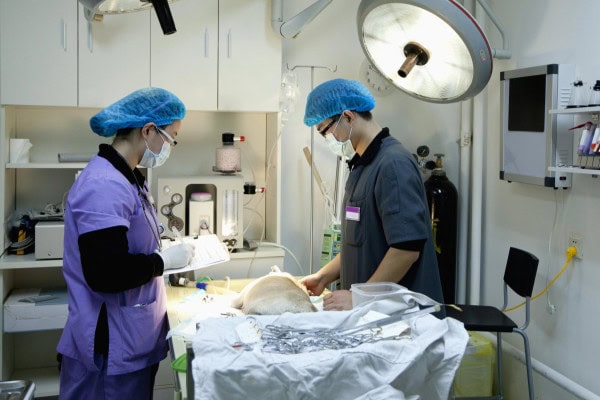
Post-op care
After carpal surgery, your dog will often need to wear a splint, bandage, cast, or external fixator on the leg for four to eight weeks to provide support. This is critical for healing because the hardware used for the repair isn’t strong enough to support the dog’s full weight. While wearing the external support device, it will be important to keep it clean and dry. And you will need to monitor your dog’s leg carefully for swelling, wounds, or other problems. Additionally, the vet will probably want to see your dog for frequent rechecks.
The vet may gradually remove the support from the leg once X-rays indicate fusion of the carpal joint. Then the dog can gradually return to his or her normal level of activity.
Additionally, dogs may benefit from physical therapy, joint supplements for dogs, and weight management after carpal surgery.
Medical management of carpal hyperextension
Unfortunately, conservative management (i.e. non-surgical treatment) does not tend to be very successful for many cases of carpal hyperextension. However, there are some exceptions.
For puppies, carpal hyperextension usually resolves with good nutrition and exercise. And for dogs weighing less than 20 pounds, medical management, including immobilizing the carpal joint with a cast, splint, bandage, or brace, can sometimes be an effective way to avoid surgical correction. But the dog will develop arthritis due to the chronic joint instability.
Additionally, minor injuries or instability may respond to medical therapy. And if carpal surgery isn’t an option, it is worth seeing how much a dog can improve with medical management before considering more drastic measures like a dog leg amputation.
Some aspects of medical management include:
Braces
It is possible to have custom dog braces made for a dog with carpal hyperextension. But according to orthopedic experts, a brace must be worn almost constantly to provide joint support. Braces can also be very expensive, close to $1500 for large breed dogs!
If the dog has a mild carpal hyperextension injury affecting the last two rows of the carpal joint, having the dog wear a custom brace for at least 6 to 12 weeks is sometimes effective. But braces can be very uncomfortable for many dogs. And they can be problematic when there is a wound or irritated skin.
During the time wearing the brace (or another means of keeping the carpus still), enough fibrous tissue can potentially surround the joint for it become stable. However, this tissue may not provide sufficient support for some dogs, especially large breed dogs. Thus, they may end up needing to wear the brace long-term or have carpal surgery.
Medications
Dogs with carpal hyperextension may benefit from oral non-steroidal anti-inflammatory drugs (NSAIDs) such as carprofen for dogs. Those veterinary-prescribed medications may be used either short or long-term depending on the dog’s pain and inflammation level. And if an NSAID isn’t sufficient or is contraindicated, the vet can also recommend other pain medications like gabapentin for dogs or tramadol for dogs.
Weight management
If your dog is overweight, he or she is putting a lot of extra weight on the already-weak carpus. Therefore, helping your dog lose weight is an important part of the treatment plan. Your vet can recommend a good weight-management food for your dog. And he or she can help you know how many calories your dog should have each day.
Physical therapy and other modalities
Dogs with carpal hyperextension can often benefit from physical therapy and exercise. Plus, additional modalities like acupuncture for dogs and laser therapy for dogs may also help reduce pain and inflammation.
Joint supplements
There aren’t really any natural treatments that can stabilize the carpus. But most dogs with carpal hyperextension can benefit from taking a good joint supplement for dogs.
My personal favorite is Dr. Buzby’s Encore Mobility™ hip and joint supplement. It contains green lipped mussel for dogs and deer velvet for dogs, two ingredients which are superstars for supporting the joints and reducing inflammation.
Alternatively, when picking a joint supplement, you should look for active ingredients like glucosamine, chondroitin, MSM, and hyaluronic acid. These components help promote joint health.
Addressing the underlying problem
If the dog has an endocrine disease or erosive arthritis as the cause for the carpal hyperextension, it is important to treat those conditions too.
What is the prognosis for canine carpal hyperextension?
Thankfully, the prognosis after carpal arthrodesis (or other carpal surgery) is good. In one study of 45 dogs who underwent pancarpal arthrodesis, 74% of dogs walked and ran normally again. And 97% of dog parents in the study were satisfied with how their dog did after surgery. Partial carpal arthrodesis also has a similar level of owner satisfaction and return to normal gait.
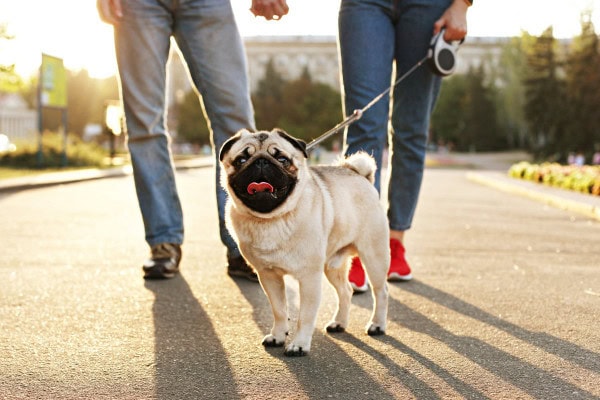
However, sometimes working dogs or doggy athletes may not be able to continue their same level of activity after carpal arthrodesis. And it may take dogs some time to get used to the new mechanics of the surgically-corrected leg.
It is also important to be aware of the fact that post-operative complications are common. Potential complications include infection, implant failure, or issues with the post-op splint or cast. In the case of infection or implant failure, the vet may end up needing to remove the hardware used for the arthrodesis surgery.
In contrast to carpal surgery, medical management of carpal hyperextension is often far less successful. The ligaments are unlikely to heal on their own. And especially with a large or overweight dog, the carpus may not be able to support the dog’s weight well without long-term use of a brace.
Work with your veterinarian
If you notice your dog is limping or one or both carpi seem to be closer to the ground than normal, please make an appointment with your vet. He or she can examine your dog, perform any necessary diagnostics, and help you get to the bottom of the issue. Whether the diagnosis ends up being carpal hyperextension or something else, the sooner you get to the vet, the sooner your dog can be on the road to recovery.
Have you ever had a dog with carpal hyperextension?
Please share his or her story below.


6 year old husky overweight tore both front carpals. He is walking on flat paws in the front. Vet put on cast bought splints. Ortho dr said he has never seen anything like this we live in a rural community have to take him 200 miles to see this ortho. What should we do
Hi Martinez,
I am so sorry your Husky has experienced this painful injury to both front paws. Honestly, I have never seen a case quite like what you are describing. I would have to defer to the orthopedic specialist for how to proceed. It does sound like weight control through dietary management will be a necessity. I encourage you to reach out to a veterinary rehabilitation professional for advice and guidance. There may be one in the same area as the ortho vet you are currently using. Hoping you can find a way to offer your boy relief and praying for a positive outcome.
My darling deerhead chihuahua rescue in 2019, aged 9y then and in excellent health, fast forward to 2023, when I noted, flat on the floor-all fours. Off to the Vet and in short, IVDD, x-rays and the like. Treatment: GABAPENTEN & TRAMADOL. and fast forward to present day 2024, doing well as can be expected. Rest is key, low fat diet. His park days are over, more like pee breaks and back in the house. He is such a darling, devoted to me, wants for nothing. Just so unfortunate. One never knows the FULL HISTORY when adopting. He aims to please all day long, loves his celery slices and carrots, and now aged 14y, more about making him comfortable. Loves his car rides and laying** in the park. He is No. 1 with me and apart from the IVDD, Excellente kidneys and heart….. He is a keeper…Long live NicholasX .
Hi Sherry,
I am glad your little guy is still living his best life despite all the hardships he must overcome each day. He sounds like a wonderful pup, and I am certain he knows how much he is loved. Thank you for sharing his story with us. Wishing you many happy days ahead and keep up the good work!